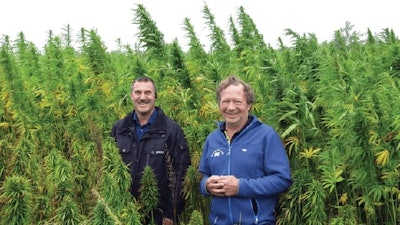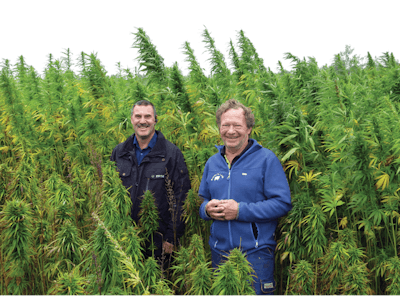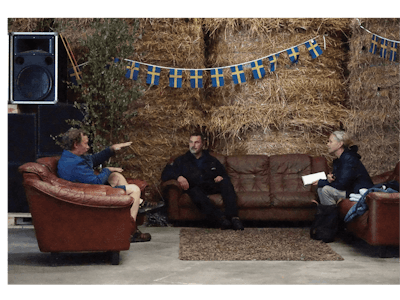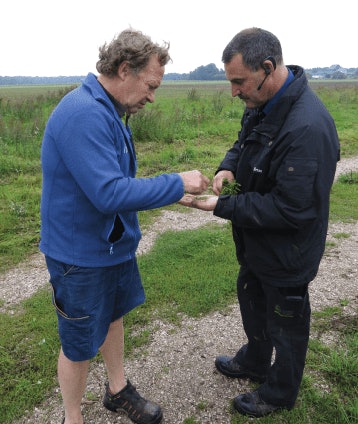

Editor’s note: This column illustrates one Swedish island’s hemp journey, from being a center for production to enduring years of prohibition to experiencing what is now a bright future.
Sunny Gotland island produces some of Sweden’s best hemp harvests. Having been a center of hemp cultivation for many years, Gotland, Sweden’s largest island, supplied the country with hemp fiber during World War II and up until 1966. During the war period, Gotland provided economic support for hemp cultivation, as many other European regions and countries did; but in 1966, government support disappeared for the farmers. The current ban in Sweden against hemp did not come until 1972, and the ban on growing hemp was not lifted until 2003. Since then, farmers have grown European Union (EU)-approved hemp varieties on the island, which has lime-rich soil and a coastal environment with abundant sunshine.
Despite Gotland’s productive soils, farmers today are forced to rethink alternatives and find new industrial crops to grow, especially since a prominent sugar factory on the island closed. While the factory had made a profit, it was moved to the mainland with the motivation to further increase profits and be closer to more sugar beet growers. After years of reliance on beets, Gotland farmers were forced to stop growing sugar beets and continue their search for profitable industrial crops.
“I am convinced that hemp is here to stay,” says Benny Nilsson, a central figure in the lengthy story of industrial hemp on Gotland, “but we must first make it work.”
Rediscovering Hemp on Gotland
The story of modern hemp cultivation on Gotland began quite dramatically. In 2001, two years before Sweden lifted its hemp ban, Nilsson decided to buy French hemp varieties to grow on several of the many nitrogen-rich drained bog lands situated around the island. He sowed a total of 5 hectares (12.4 acres) of hemp and was amazed at how well the crop grew on these lands.
Unfortunately, this experimental cultivation ended abruptly. Because he was the one who sowed the hemp, he was prosecuted for drug possession in 2002, as the authorities at that time had yet to follow the EU standards that had lifted restrictions on hemp fiber and seed cultivation. Adding insult to injury, Nilsson was ordered to harvest the crop that had by this time reached almost 5 meters (16.4 feet) in height. So, he drove into the fields and harvested the hemp with his reaper-binder. When police confiscated his harvest, they estimated it weighed 12 tons. They burned it all.
“During this period, my neighbors nicknamed me ‘Escobar,’” Nilsson says, laughing, but he becomes more serious when explaining it was also tiring to face so much resistance.
Although he no longer grows hemp himself, he continues working as he has since the beginning to involve more farmers and increase the number of hemp fields on the island. Nilsson shares firsthand knowledge of cultivation, seed varieties, and processing, but above all, which machines are required to harvest and sort hemp fiber and seed crops.
“At this moment, I am looking at how insulation fibers can be extracted advantageously without drying and retting,” Nilsson says. “Instead, we can run the stalks through the process [when they’re still] green.” He goes on to describe some problems with bulky dried hemp stalks, including the need for large storage facilities.
“Of course, the most profitable is to use hemp as biofuel, but I think it is almost sinful to burn these fantastically strong fibers,” he says, adding that his dream is to first separate the fibers and only use the shives (hurds) as wood chips to heat boilers. Still, growing hemp for biofuel in Sweden is profitable—Nilsson calculates that when growing stalks for biofuel, hemp returns $1,400 USD per hectare, which is more than wheat returns.
Swedish hemp growers must apply for farm support through the Swedish Board of Agriculture rather than requesting permits or licenses, as in many other countries. If they do not, their crop will be considered illegal and subject to seizure and destruction. The rules state that cultivators may only grow EU-approved varieties on at least 4 hectares (9.9 acres) for stalks and/or seed. Cultivators growing hemp for cannabinoids have been known to cause problems with the authorities, and several people have been prosecuted for doing so in recent years.

Dual-Cropping and Market Opportunities
Nilsson, who also raises beef cattle and is interested in fodder crops such as maize, runs the agricultural machinery company Bondarve LBM.
A few years ago, Nilsson and his team developed a hemp-specific harvester for which they received a patent. Today, the protection has expired, as it is costly for a machine manufacturer to repeatedly pay patent fees. Still, it was an important step toward solving the problem of harvesting both tall stems for biomass and ripe seeds without compromising the quality of either product in the process.
At the nearby farm of Anders Thunegård, we viewed the machine, which Thunegård will soon put to use. In addition to Thunegård’s profession as a rapeseed grower, he also has extensive experience with hemp cultivation. This year, he sowed both the Finola variety, from Finland, for seed production and the Fedora variety, from France, for fiber and shives. Both stand side by side in neighboring fields.
“I believe more in the model of growing different varieties than trying to extract too many fractions from one and the same variety,” says Thunegård, adding that without this new technology, he would never have grown this year.
Thunegård describes his previous challenges with harvesting, including dealing with stalks of inconsistent heights, which present difficulties because the reaper-binder must be moved up and down while driving the combine.
This year, a company on mainland Sweden has contracted with Thunegård to grow hemp for seeds, fiber, and shives, so he decided to cultivate two crops. Whole seeds from Finola will be pressed into oil, and hulled seeds will be added to muesli. Fiber from Fedora stalks will be used to manufacture building insulation, and the shives will be used in hempcrete. Thunegård also wants to extract the seeds from Fedora, but he is uncertain if they will fully ripen.
“Last year, I harvested nice seeds, which I had packed and sold as birdseed,” he explains, adding that he made a good profit. He likes the idea of growing hemp and marketing products without too many links in the sales chain.
“Not long ago, IKEA got in touch and wanted to contract us to grow hemp to produce chipboard,” Thunegård says. However, it became an impossible equation due to, among other things, transport costs. “IKEA manufactures products in huge volumes and would require three large trucks filled with chips every day for transport to the mainland. There would be no profit left for us, so the project was discontinued.” (IKEA could not be reached for comment.)
Both Thunegård and Nilsson believe having a smaller scale of production is beneficial, as it generates profits that go directly into the hands of growers. They also believe in sharing equipment for processing stalks and separating the fiber and shives, and they recently invested in a jointly owned seed dehuller. After all, the challenge isn’t growing hemp, but rather the expenses of harvesting and processing machines. Both Thunegård and Nilsson are convinced that the soil and climate on Gotland are perfect for hemp cultivation and that eventually they will solve their processing problems.

Building on Gotland’s Hemp Production Past
The availability of processing lines was one of the reasons Gotland hemp was so successful from World War II through the 1960s. During this time, a factory receiving support from the Swedish government was situated near the fields in the island’s capital, Visby. This meant growers did not need to store the bulky stalks, and more than 100 farms provided the factory with long, strong fibers for rope production. Before support dried up, government investigations showed hemp yielded exceptional crop value, especially when grown on the lime-rich bog soils.
Government reports also showed hemp needs soils that are rich in nutrients, mainly nitrogen and phosphorus. Additionally, they showed that young plants quickly formed a canopy that shades the soil surface, inhibiting weed growth without applying herbicides. Pest infestations and fungal infections were rare, and when they did occur, they remained localized without spreading through the entire population and reaching economic thresholds. In addition, hemp provided many jobs during the period. Despite these favorable reports, as in many other European countries, state financial support disappeared, and so did hemp from Gotland’s fields.
“Just like in the old days, I still grow hemp on bog land,” says Thunegård. “It’s extremely good because it drains well while retaining moisture and rarely requires irrigation other than rainfall.”
During Gotland’s most successful hemp cultivation years of the 1950s, the monoecious hemp variety Mona was developed. Although well-adapted to producing both fiber and seed in Swedish conditions, this variety is no longer available, nor is it preserved in Swedish seed banks.
“Still, I found a farmer with old Mona seeds in his attic,” says Nilsson. Nilsson tried to grow them for a year, but the seeds were too old to germinate.
Even Finola was problematic to grow in the early 2000s when authorities reported it exceeded the EU’s then maximum allowable content of 0.2% THC. Therefore, Finola was banned for a while.
“At that time, we grew other varieties instead, like one from Ukraine, which also yielded a large seed harvest,” Nilsson remembers.
Finola has since returned to Sweden as an approved EU cultivar and can now have up to 0.3% THC, as the European Parliament in 2020 voted to increase the EU’s maximum allowable THC content in hemp to 0.3%.
When we visited Nilsson and Thunegård in August, they examined and tasted this year’s Finola crop, a vigorous variety filling with seeds, but by the end of August, not all of them had ripened. Later in September, Thunegård’s Finola harvest yielded 1,200 kilograms per hectare (about 1,070 pounds per acre) of seed. He chose to not harvest the taller Fedora field this autumn, and instead decided to wait until spring. The fiber crop will stand on the field through the winter drying and become slightly retted, making it easier to harvest and separate the shives from the fiber.
Despite nearly 20 years of legalization, hemp cultivators in Sweden still have challenges to overcome. But there is no doubt that in the hands of Gotland’s innovative farmers, hemp has a long future ahead.












